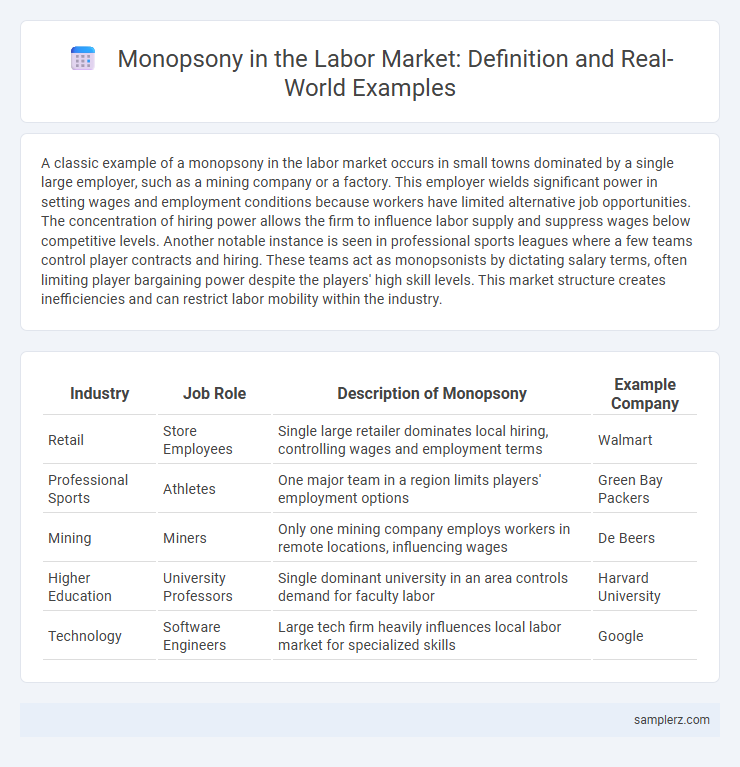A classic example of a monopsony in the labor market occurs in small towns dominated by a single large employer, such as a mining company or a factory. This employer wields significant power in setting wages and employment conditions because workers have limited alternative job opportunities. The concentration of hiring power allows the firm to influence labor supply and suppress wages below competitive levels. Another notable instance is seen in professional sports leagues where a few teams control player contracts and hiring. These teams act as monopsonists by dictating salary terms, often limiting player bargaining power despite the players' high skill levels. This market structure creates inefficiencies and can restrict labor mobility within the industry.
Table of Comparison
| Industry | Job Role | Description of Monopsony | Example Company |
|---|---|---|---|
| Retail | Store Employees | Single large retailer dominates local hiring, controlling wages and employment terms | Walmart |
| Professional Sports | Athletes | One major team in a region limits players' employment options | Green Bay Packers |
| Mining | Miners | Only one mining company employs workers in remote locations, influencing wages | De Beers |
| Higher Education | University Professors | Single dominant university in an area controls demand for faculty labor | Harvard University |
| Technology | Software Engineers | Large tech firm heavily influences local labor market for specialized skills |
Defining Monopsony in the Labor Market
A monopsony in the labor market occurs when a single employer has substantial control over the hiring and wage-setting process, limiting competition for workers. This market structure allows the employer to set wages below competitive levels, reducing labor mobility and suppressing overall worker income. Examples include small towns with one dominant factory or hospital, where workers have few alternative employment options.
Classic Examples of Labor Market Monopsony
A classic example of labor market monopsony is a company town where a single employer, such as a mining or logging company, dominates local employment, limiting workers' alternative job options and suppressing wages. Another example is large retail chains or manufacturers in rural areas with limited competing employers, giving these firms significant power over wage-setting. These monopsonistic conditions result in reduced labor mobility and lower wage growth compared to competitive labor markets.
Monopsony Power in Rural Healthcare Employment
Monopsony power in rural healthcare employment occurs when a single or limited number of employers dominate the labor market, restricting wage growth and worker mobility. Rural hospitals and clinics often serve as the primary employers for healthcare professionals, leading to reduced competition and lower bargaining power for nurses and doctors. This concentrated employer power can result in stagnant wages and workforce shortages, impacting the quality of healthcare services in rural areas.
The Role of Major Retailers as Monopsonists
Major retailers often act as monopsonists in labor markets by being the dominant employers in certain geographic regions, thus exercising substantial wage-setting power over workers. Their market control limits job alternatives for employees, resulting in suppressed wages and reduced employment conditions. This monopsonistic behavior highlights significant implications for labor market efficiency and worker welfare.
Tech Giants and Their Influence on Local Labor Markets
Tech giants like Amazon and Google act as prominent monopsonies in local labor markets, exerting significant control over wage levels and employment conditions. Their dominant hiring power limits workers' alternatives, often suppressing wages despite increasing demand for skilled labor. This market influence reshapes regional employment dynamics and can stifle competition among employers.
Public Education Systems as Monopsonistic Employers
Public education systems act as monopsonistic employers by dominating the labor market for teachers, thus limiting their employment options. This concentration allows school districts to set wages below competitive levels, impacting teacher salaries and benefits. The monopsony power of public education often results in reduced bargaining leverage for educators and constrained labor market mobility.
Agricultural Monopsony: Seasonal Workforces
In agricultural labor markets, a monopsony occurs when a single or few large farm owners dominate hiring seasonal workers, limiting the number of available employers. This market structure allows employers to set lower wages and reduce worker bargaining power, as seasonal laborers have few alternative job options. The imbalance often results in suppressed wages and limited labor mobility within rural agricultural communities.
The Gig Economy and Modern Monopsony Dynamics
The gig economy exemplifies modern monopsony dynamics by concentrating hiring power among a few dominant platforms such as Uber, DoorDash, and TaskRabbit. These platforms control labor demand, enabling them to set wages below competitive market levels while limiting workers' bargaining power. This monopsonistic control influences job availability, compensation structures, and labor conditions within the gig sector.
Policy Implications of Monopsony in Labor Markets
Monopsony in labor markets, such as large employers in rural areas or specialized industries, can lead to suppressed wages and reduced worker mobility due to limited employment options. Policy implications include the need for stronger antitrust enforcement, minimum wage laws, and support for labor unionization to balance employer power and improve labor market competitiveness. Enhancing transparency in job openings and promoting workforce mobility through training programs can mitigate monopsonistic labor market distortions.
Addressing Wage Suppression in Monopsonistic Environments
Monopsony in the labor market occurs when a single employer dominates hiring, limiting workers' bargaining power and causing wage suppression below competitive levels. Policies such as increasing minimum wages, strengthening collective bargaining rights, and enforcing antitrust laws can effectively counteract monopsonistic wage suppression. Empirical studies show that raising minimum wages in monopsonistic markets often leads to higher wages without significant job losses, improving worker welfare and reducing income inequality.

example of monopsony in labor market Infographic
 samplerz.com
samplerz.com